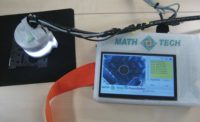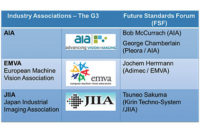
New USB 3.0 cable connectors are one benefit of the specification. Source: Newnex Technology Corp.
Lately there has been a lot of discussion surrounding the latest version of the USB specification. This new version, v3.0, is being promoted as the next best thing. From the inception of the PC, USB has and continues to be one of the most popular data bus interfaces for the modern computer.
Not only is USB powering the keyboard and mouse, but also machine vision cameras and paraphernalia, external hard drives, iPods and cell phones. Increasingly, more and more applications and electronic devices rely on USB connectors to power their appliances, as they are relatively inexpensive and, most importantly, standardized.
Why USB 3.0?
With USB commercially available, why the need for USB 3.0? How it will affect machine vision applications?USB 3.0 is the next generation bus technology for computer peripherals. Benefits include, but are not limited to, increased speed providing data rates of 5 gigabits (Gbits) per second-10 times faster than USB 2.0 and five times faster than Gigabit Ethernet; full duplex signaling and communication; and additional power over the USB bus with better power management and three new USB connectors/plugs.
The USB 3.0 specification finally brings full duplex signaling and communication to USB devices. As a result, multiple devices can be controlled at the same time, whereas in the past only one device had control of the USB bus at any given point. The host PC would grant a timeslot for each device to transfer data either to or from the host, commonly known as half duplexing.
With full duplexing, USB 3.0 devices can send and receive data simultaneously, thereby minimizing latency for command and control of the device or data transfers. This is achieved through four additional twisted copper pairs within the USB 3.0 cable. These extra signal lines provide the 5 Gbits/second data rates along with the full duplexing of data transfers.
Additional speed and bandwidth usually come at a price. Faster devices typically require more power to run. As such, the USB 3.0 specification addresses this issue by allowing more power to be drawn from the USB 3.0 bus. As with all USB specifications, a USB device can only draw a portion of the maximum current available when it is being configured. After it has properly enumerated, it is then allowed to draw up to the maximum current for the bus.
With USB 2.0, these current values are 100 milliamperes (mA) during configuration and 500 mA afterward. These values have increased with USB 3.0 to 150 mA and 900 mA. The drawback to this increase is the minimum voltage for a USB 3.0 device could range from 4 to 5 volts, which is down from 4.4 to 5 volts with USB 2.0. In most cases, USB devices will be able to manage the lower voltage with the additional current provided by the bus.
With the additional power provisions, the founders of the USB 3.0 specification did not forget about going green. They have incorporated new and additional support for power management. On top of the existing power management states provided by USB 2.0, three new ones have been added. Idle, sleep and suspend states will help manage the overall power requirements of the application and ensure wasted power is minimized.
As a result of the aforementioned changes, three USB 3.0 connectors have been introduced: a new A-type (host-based) connector/plug; a new standard B-type; and a mini-B type (device-based) connector/plug. These plugs are designed to be backward-compatible with USB 2.0 cables and mate properly with an equivalent USB 2.0 connector. Both the USB 3.0 host root hub and device are designed to detect the various USB devices between each other and adjust their speed and signaling accordingly. As a result, if a USB 3.0 device such as a camera is connected to a host PC with a USB 2.0 port, the camera is designed to only run at USB 2.0 data rates and draw the appropriate current so as to not exceed the maximum power allowed.
Imaging with USB 3.0
Many of the machine vision cameras currently on the market may not see an immediate boost in performance when they migrate to USB 3.0. This is due to the fact that the sensor, when running at its peak, cannot provide enough data to max out a standard transportation bus.Take the case of a 1.3 megapixel complementary metal oxide semiconductor (CMOS) sensor running at 30 frames per second (fps) that produces 40 megabytes (MB) of data per second, assuming 8 bits/pixel. USB 2.0 running at 480 megabits (Mbit)/second can easily handle this amount of data so migrating this camera to USB 3.0 would not provide any additional frame rates.
However, where one would benefit from a USB 3.0 platform is in the ability to now run up to 10 1.3 megapixel cameras at once on a single USB root hub. In the past, 10 separate root hubs were required, thus helping with budgets and space constraints. Additionally, in order to manage the full data from these 10 cameras on USB 2.0, one would need a powerful motherboard that could support 10 full USB root hubs with a very fast PCI bus. USB 3.0 will better manage the volumes of data coming from the cameras and other peripherals and will require less hardware in the process.
Another benefit gained with USB 3.0 is that the additional bandwidth allows camera manufacturers access to new larger, faster sensors. As more and more sensors are switching to an HD format of 1080p30 (1080 represents 1,080 lines of vertical resolution and p stands for progressive scan), 1080p60 or larger, the demand on bandwidth increases, particularly when transmitting raw, uncompressed data.
USB 3.0 provides a very large pipe designed to transfer the necessary volume of data that these sensors require. As a result, end users for these types of camera products do not need expensive customized bus technologies, and greatly reduce costs with off-the-shelf cabling and interface cards while not sacrificing camera performance or budgets.
When?
In theory USB 3.0 devices and all the technology has to offer is now accessible; however, in practicality 2011 is a more realistic availability date. The likelihood of USB 3.0 production-ready machine vision cameras and devices along with other necessary components being ready in 2010 is very slim. Daily, manufacturers are announcing the unveiling of their first USB 3.0 devices.In order for USB 3.0 to become a standard feature, a testing and integration period is required. These new devices will need to interoperate so as to ensure they do not interfere with each other’s functionality. Motherboard manufacturers will have to integrate this new technology onto their next generation products, and operating systems will require the addition of USB 3.0 driver root hubs and class drivers into their new and existing platforms.
Additionally, for the time being support will be provided by the USB 3.0 device manufacturer, which could see more incompatibility issues with other USB device drivers or with the operating system itself.
Finally, as this is a new technology, the prices for these devices will naturally be higher until demand drives them down. As such, only early adapters will commit to buying these products at this stage, with the mainstream buyers partaking in 2011.
USB 3.0 is coming and will be here to stay. It will be as successful as its predecessor, both on its price/performance ratio and its acceptance in the market. The fact that it is designed to be backward-compatible will allow faster market acceptance and have a larger impact. The bigger data pipe at 5 Gbits/second will allow machine vision camera manufacturers in particular to take advantage of bigger, faster sensors at lower costs, thus opening up new, higher-end markets that were once inaccessible. USB is moving from great to even greater, and it is something to look forward to. V&S


